The Idiot was particularly careful, while MedTrekking through the notorious Gorge of Death near Zakros in eastern Crete, to conscientiously check out every cave, cranny, crevice and shadow.
This was not because he had suddenly developed an interest in bats, bones and/or dead body parts (the gorge got its name because the caves were used as graves by ancient Minoans). Nor was it because May 20 was his last day MedTrekking in Crete before ferrying to Rhodes.
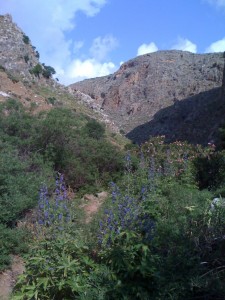
Entering the shadowy Gorge of Death.
The Idiot’s enthusiasm was due to a remark that Joseph Alexander “Sandy” MacGillivray, an ace archeologist and author of “Minotaur: Sir Arthur Evans and the Archaeology of the Minoan Myth,” made during lunch at the Kakavia Fish Taverna on Palekastro’s Chiona beach the day before.
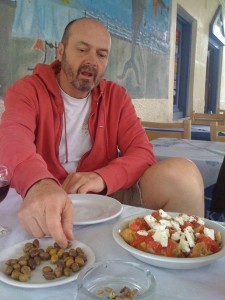
Archeologist Sandy MacGillivray at the popular Kakavia Fish Taverna.
“The local government in Zakros wanted to change the name of the ‘Gorge of Death’ to the ‘Valley of Life’ to make it more attractive to tourists,” said the Canadian-born and bearded MacGillivray during a stormy and thundering afternoon that we both agreed was atmospherically charged because Zeus was trying to tell us something. “But the change never occurred. Incidentally, keep your eyes open because you might find the real cave of Zeus there.”
“WHAT?”
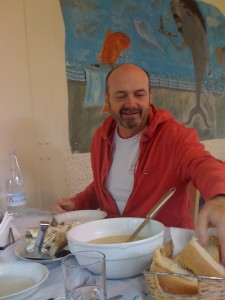
Fish Soup Bombshell: Zeus cave still undiscovered!
“Follow the Idiot” aficionados will recall that The Idiot has already claimed to find the cave where Zeus was born and/or raised in Crete – twice. Once on Mount Ida (http://bit.ly/j9DYOo) in a snippet called “The View From Zeus’ Crib,” another time on Mount Dikti (http://bit.ly/iLDojI) in an item entitled “The Colossal Cretan Cave Conundrum.”
But Sandy – casually making references to Pythagoras, Socrates, Strabo, DNA, quantum physics, the Anatolian migration, Linear A tablets, and competition between academic archeologists – convinced The Idiot that the actual Zeus cave still hasn’t been found as we slowly enjoyed Olga’s spellbinding fish soup.

Olga’s magical fish soup encouraged Sandy to tell historical and mythical tales.
“The real cave would contain lots of post-Minoan material and, according to a variety of sources including Pythagoras who spent time there, it is located here in eastern Crete,” said Sandy, the co-director of the British School of Archaeology at Athens’ Palekastro excavations who has been involved with the dig in nearby Roussolakkos, a Minoan town than includes a sanctuary of Diktaian Zeus, since 1983. “I’m trying to find speleologists to conduct a serious search but of course we don’t know if the cave was buried by Christians or an earthquake. Anyone could find it or it may never be found.”
“The Idiot is on the case beginning tomorrow,” I promised as we munched on honeyed halva.
The discussion continued as Sandy drove his 1979 BMW to the archeological site and described how his ever-changing team of volunteers has made and processed thousands of finds, including the Palekastro Kouros, a youthful male figure dating from 1500 BC that’s carved in hippopotamus ivory, clothed in gold and has eyes of rock crystal and a serpentine head.
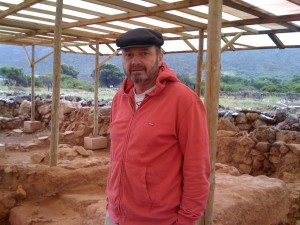
Roussolakkos: The Palekastro Kouros was found here.
Hundreds of fragments of the culturally valuable and historically significant statuette, which has been restored and is about 18 inches high, were found in the late 1980s by Sean Hemingway, Ernest’s grandson and an associate curator at the Department of Greek and Roman Art at the Metropolitan Museum in New York who returns to the dig at Palekastro almost every summer.
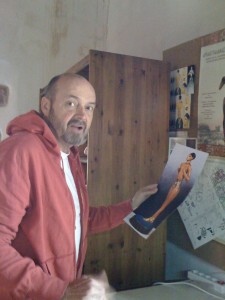
Sandy with an artist’s rendering of the Palekastro Kouros.
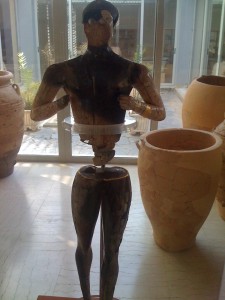
The Palekastro Kouros in the Sitia Archeological Museum.
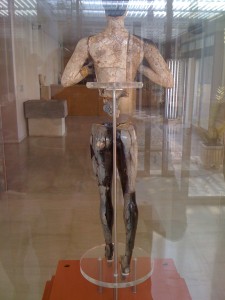
Rear view of the Palekastro Kouros.
“If Sean can find something of that size, I can find the Zeus cave,” The Idiot proclaimed while Sandy made late afternoon tea at the stone dig house that’s owned by the monks at the nearby Toplou monastery and filled with boxes labeled “Shell,” “Marine Organism,” and “Fish Bones.”

Sandy in the dig house with his book and boxes.
The patient and practiced archeologist tried to be encouraging.
“Every time I take a walk in the hills around here I literally stumble upon something ancient,” said Sandy, who taught at Columbia University in New York for a decade, still jumps off local cliffs into the Mediterranean and now lives with his wife and two kids in Athens. “You may get lucky because we estimate that ninety percent of Minoan sites in Crete have yet to be discovered. And the myth versus history equation is forever fascinating.”

Gorge of Death: Is this the Zeus cave?
Text and iPhone Photos: Joel Stratte-McClure

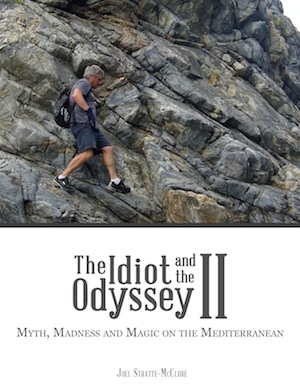


 Follow
Follow
7 Responses to Coming Alive In Crete’s Shadowy “Gorge Of Death”